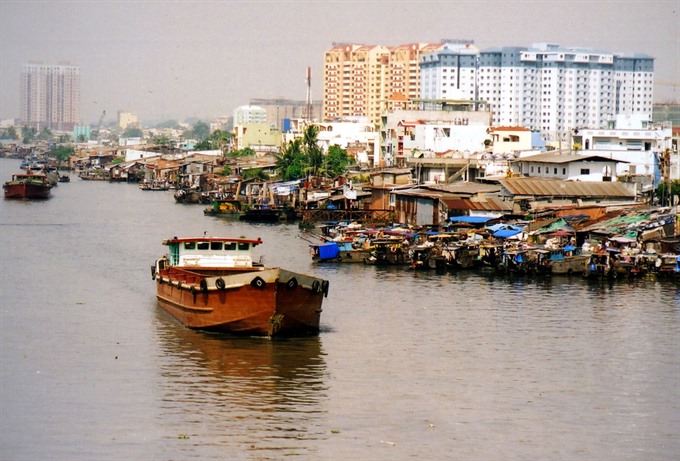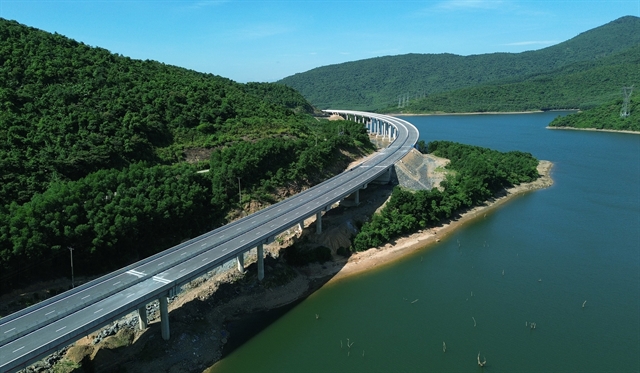 Society
Society

Concerted efforts are needed to reduce pollution and improve the landscape near slums along canals and rivers in HCM City, including investment from the private sector, speakers said at a workshop held on Monday.
 |
| The hustle and bustle of ship and boat traffic on the Tẻ Canal, which is lined with dilapidated slums in District 7, HCM City. - VNA/VNS Photo Văn Khánh |
HCM CITY — Concerted efforts are needed to reduce pollution and improve the landscape near slums along canals and rivers in HCM City, including investment from the private sector, speakers said at a workshop held on Monday.
Speaking at a workshop on city slums, organised by the HCM City Architects Association, Dr. Lê Huy Bá, said that nearly all canals and rivers in the city were now heavily polluted.
Most canals and rivers have been encroached upon by residents living along the canals and rivers, with more than 22 per cent of the water surface used to build houses and other concrete works.
As of July 15, the city had discovered hundreds of cases in which residents had built illegal housing near the sewer systems of canals and rivers, which led to serious flooding during heavy rains.
Architect Lê Minh Thành of the HCM City Architects Association said that foul odours were another issue, especially at the Tàu Hủ - Bến Nghé canal in District 1 and Tham Lương canal in District 12.
Even the Nhiêu Lộc - Thị Nghè canal, which was recently renovated at a cost of US$350 million, emits a bad odour, especially when the tide ebbs.
HCM City has 5,000km of canals and rivers that help drain water, thus curbing floods.
The city has been able to dredge only 80 km of canals and rivers during the past several decades, Bá said.
Thái Ngọc Hùng, an architect, said all of the houses in slums along the canals and rivers had caused serious pollution and destroyed the urban landscape.
"The households need to be relocated as soon as possible," he added.
However, architect Nguyễn Trường Lưu, chairman of the HCM City Architect Association, said the city was continuing to struggle to seek funds for projects to improve the areas near canals and rivers in the city.
In the past, capital for such projects came from Official Development Assistance (ODA) loans and the state budget.
But now the city has to call for investment from the private sector in and outside the country.
Also, speaking at the workshop, architect Ngô Viết Nam Sơn said it was difficult to resettle the affected residents due to a shortage of capital for relocation.
Sơn said the city must create special incentives to attract more investment from the private sector for projects that would improve the environment and landscape near canals and rivers.
He also called for long-term plans to reduce pollution and improve the landscape of canals, rivers, lakes and green zones in the city.
Dr Lê Văn Thương, rector of the HCM City University of Architecture, said the city’s most recent landscape project near Nhiêu Lộc-Thị Nghè canal had been ineffective and expensive, and that more efficient alternatives were needed.
“The city needs to invite investors to join the process of urban planning to suggest the best solutions,” Thương said at the meeting.
Dr Nguyễn Thiềm said the city should abolish Decision 150/2004/QĐ-UB that regulates space needed for the planting of trees along canals or rivers. He said the space required would be a waste of the land fund.
The city should save the land for investors to operate cafes and restaurants along the rivers and canals, which could help develop tourism activities, Thiềm said.
City authorities have been struggling to seek funds for a project to relocate people living in 20,000 houses in slums along canals and rivers by 2020.
The slums, mainly located in districts 4, 7, 8 and Bình Thạnh, have more than 100,000 people living in unsafe and filthy conditions.
The houses, built with temporary materials, are in serious disrepair and often lack toilets. Most of their residents lack steady jobs.
District 8 accounts for nearly 50 per cent of the slums, with more than 1,000 houses lacking toilets and located in severely polluted areas, according to an official of the district People’s Committee.
The city has developed a master plan for District 8 that envisages building apartments with blocks of 20 – 25 floors each for 20,000 people on 75 hectares along the Đôi Canal.
Around half of the land would be earmarked for green space and public and resettlement use.
Lê Văn Khoa, deputy chairman of the city People’s Council, said slums had existed along canals for more than half a century. The city plans to invite investors to build housing for the relocated slum residents, he said.
To make the plan possible, the city is considering options like using more Official Development Assistance (ODA), inviting foreign investors, and reviewing all public land available.
Trần Trọng Tuấn, director of the city’s Department of Construction, said his department would work with the Department of Planning and Architecture, consultancy agencies from the private sector and architects to suggest the best solutions.
Tất Thành Cang, deputy secretary of HCM City’s Party Committee, praised the ideas and recommendations at the workshop.
He said the city would take into account all opinions and ideas about the best solutions to improve the areas near the canals and rivers. — VNS
 |
| HCM City’s District 8 accounts for 50 per cent of the city’s slums, with more than 1,000 houses lacking toilets and located in seriously polluted areas. — VNA/VNS Photo Thanh Phàn |




